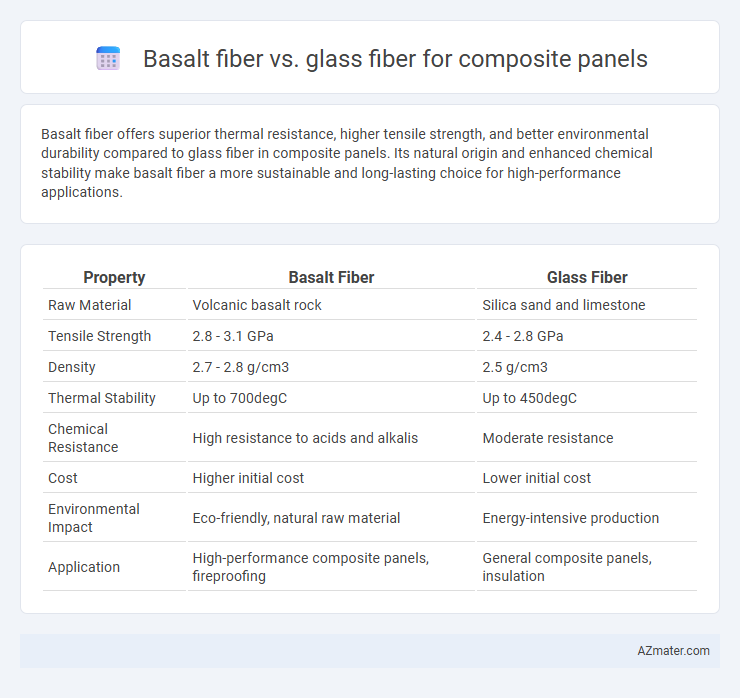Basalt fiber offers superior thermal resistance, higher tensile strength, and better environmental durability compared to glass fiber in composite panels. Its natural origin and enhanced chemical stability make basalt fiber a more sustainable and long-lasting choice for high-performance applications.
Table of Comparison
| Property | Basalt Fiber | Glass Fiber |
|---|---|---|
| Raw Material | Volcanic basalt rock | Silica sand and limestone |
| Tensile Strength | 2.8 - 3.1 GPa | 2.4 - 2.8 GPa |
| Density | 2.7 - 2.8 g/cm3 | 2.5 g/cm3 |
| Thermal Stability | Up to 700degC | Up to 450degC |
| Chemical Resistance | High resistance to acids and alkalis | Moderate resistance |
| Cost | Higher initial cost | Lower initial cost |
| Environmental Impact | Eco-friendly, natural raw material | Energy-intensive production |
| Application | High-performance composite panels, fireproofing | General composite panels, insulation |
Introduction to Composite Panels
Basalt fiber and glass fiber are key reinforcement materials in composite panels, offering distinct mechanical and thermal properties crucial for engineering applications. Basalt fiber exhibits higher tensile strength, better chemical resistance, and improved thermal stability compared to traditional glass fiber, enhancing the durability and lifespan of composite panels. These characteristics make basalt fiber composites ideal for construction, automotive, and aerospace industries seeking lightweight yet robust materials.
What is Basalt Fiber?
Basalt fiber is a natural fiber made from fine fibers of basalt rock, known for its high tensile strength, thermal stability, and resistance to chemical corrosion, making it an ideal material for composite panels. Unlike glass fiber, basalt fiber offers better environmental resistance and improved mechanical performance, contributing to enhanced durability and longevity in construction and industrial applications. Its eco-friendly production process and superior insulation properties position basalt fiber as a sustainable alternative in advanced composite manufacturing.
What is Glass Fiber?
Glass fiber, also known as fiberglass, is composed of fine strands of silica-based glass used to reinforce composite panels. It offers high tensile strength, corrosion resistance, and thermal stability, making it a popular choice in construction and automotive industries. Compared to basalt fiber, glass fiber is more cost-effective but has lower impact resistance and environmental durability.
Production Process: Basalt vs Glass Fiber
Basalt fiber production involves melting natural basalt rock at temperatures around 1,400degC followed by fiberizing through a mechanical process, resulting in a more environmentally friendly and energy-efficient method compared to glass fiber. Glass fiber production requires melting silica sand and other raw materials at higher temperatures near 1,500degC, then extruding through fine orifices to form continuous fibers, which typically consumes more energy and involves more complex raw material processing. The simpler production process and natural raw material source make basalt fiber a sustainable alternative with potentially lower carbon emissions than conventional glass fiber.
Mechanical Properties Comparison
Basalt fiber exhibits higher tensile strength, typically ranging from 2.8 to 3.1 GPa, compared to glass fiber's tensile strength of 2.0 to 2.5 GPa, making basalt fiber composites more resistant to mechanical stress. The modulus of elasticity for basalt fiber, approximately 85 to 105 GPa, generally surpasses that of E-glass fibers, which is around 70 to 75 GPa, resulting in improved stiffness and dimensional stability in composite panels. Basalt fiber also offers enhanced impact resistance and better fatigue performance, contributing to longer service life and superior mechanical integrity in demanding applications compared to conventional glass fiber composites.
Thermal and Chemical Resistance
Basalt fiber exhibits superior thermal resistance with a melting point around 1400degC, significantly higher than glass fiber's typical range of 700-900degC, making it ideal for high-temperature composite panels. Chemically, basalt fibers resist acids, alkalis, and salts more effectively than glass fibers, which can degrade faster in corrosive environments. This enhanced thermal and chemical stability results in basalt fiber composites offering longer durability and improved performance in harsh conditions compared to traditional glass fiber panels.
Weight and Density Differences
Basalt fiber exhibits a lower density of approximately 2.7 g/cm3 compared to glass fiber's density near 2.5 g/cm3, resulting in marginally heavier composite panels when basalt fibers are used. Despite this, basalt fiber panels often achieve superior strength-to-weight ratios, enabling lighter structural designs in certain applications. The slight weight increase from basalt fiber density is balanced by enhanced mechanical properties, making it preferable for high-performance composite panels.
Cost Analysis: Basalt vs Glass Fiber
Basalt fiber offers a competitive cost advantage over glass fiber in composite panels due to lower raw material and production expenses, with prices typically ranging from 1.2 to 1.5 times that of glass fiber. Although glass fiber remains cheaper upfront, basalt fiber's enhanced durability and longer lifecycle reduce maintenance and replacement costs, improving overall cost-effectiveness. Cost analysis also highlights basalt fiber's superior mechanical properties, which can lead to thinner, lighter panels and potential savings in structural design and transportation.
Environmental Impact and Sustainability
Basalt fiber demonstrates a significantly lower environmental impact compared to glass fiber due to its natural volcanic rock origin, requiring less energy-intensive processing and producing fewer emissions during manufacturing. Its higher durability and recyclability contribute to enhanced sustainability, extending the lifespan of composite panels and reducing waste accumulation. Glass fiber, though widely used, involves more energy consumption and higher carbon emissions, making basalt fiber a more eco-friendly and sustainable option for composite panel applications.
Applications in Composite Panels
Basalt fiber offers superior thermal resistance, chemical stability, and mechanical strength compared to glass fiber, making it ideal for high-performance composite panels in construction, automotive, and aerospace applications. Composite panels reinforced with basalt fiber provide enhanced durability and impact resistance, especially in environments exposed to extreme temperatures and corrosive substances. Glass fiber remains popular in budget-sensitive projects due to its cost-effectiveness and ease of manufacturing, but basalt fiber composites deliver longer service life and improved structural integrity in advanced industrial uses.

Infographic: Basalt fiber vs Glass fiber for composite panel
 azmater.com
azmater.com